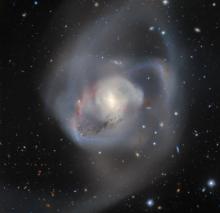Listen to today's episode of StarDate on the web the same day it airs in high-quality streaming audio without any extra ads or announcements. Choose a $8 one-month pass, or listen every day for a year for just $30.
You are here
Galactic Fossils
Green Peas are like living fossils. Not the hard little nuggets that get overzapped in the microwave. These are small, busy galaxy nuggets. Astronomers have found several of them in the modern universe. But in its very first picture, James Webb Space Telescope found some in deep space — when the universe was less than a billion years old. That makes the close ones living fossils — as one astronomer described them, the coelacanths of galaxies.
Green Peas were discovered in 2007. They were fairly close — within a couple of billion light-years. They’re dense, round knots a few thousand light-years across — a few percent the size of the Milky Way. They’re giving birth to many stars. They get their color from the glow of hot gas — a lot of it. The combination of gas and rapid starbirth means they’re pristine — they’re just starting to take shape.
Webb discovered three Green Peas in its first picture of the deep universe, which covered a tiny fleck of sky. They’re the same size as the modern Green Peas. They have the same structure and composition. And they’re at the same stage in life — they’re just getting cranked up, so they’re giving birth to a lot of stars.
But these Green Peas are 13.1 billion years old. That means we’re seeing them as they looked when the universe was only 700 million years old.
So the modern Green Peas are like living fossils — modern versions of some of the first galaxies in the universe.
Script by Damond Benningfield





